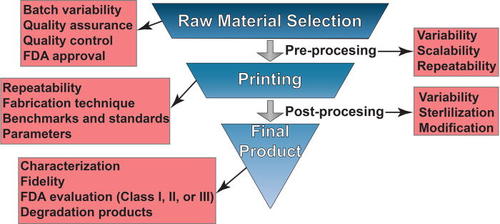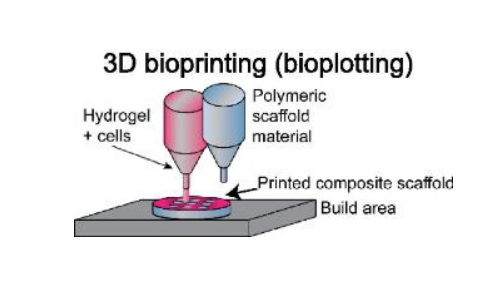Authors Jesse K. Placone, Bhushan Mahadik, and John P. Fisher explore the benefits and challenges of tissue engineering. In the recently published ‘Addressing present pitfalls in 3D printing for tissue engineering to enhance future potential,’ the authors also address the future potential for 3D printing, and accompanying materials and techniques.
Noting that bioprinting is intrinsically limited due to the difficulty in sustaining human tissue, the authors explore how obstacles can be overcome, as well as the potential for use in ‘academic, clinical, and commercial settings.’ Many researchers today are also focused on tissue engineering for cells to be used both in vitro and in vivo. Due to challenges with size, nutrients for cells, and waste diffusion, many studies today are centered around creating microvasculature.
Popular materials for use in bioprinting are polycaprolactone (PCL), poly(lactic-co-glycolic acid) (PLGA), and polystyrene (PS), along with a variety of bioinks, and a range of techniques.
“Particularly, there is a high degree of freedom when 3D printing acellular, single-material constructs with either hydrogels or thermoplastics,” state the authors.
The use of multi-material printing with hybrid bioinks is becoming increasingly popular too, allowing for successful fabrication of bone mimetics, for example, creating rigid support materials as well as softer ones for ‘the desired cellular response.’ While a wide range of research studies have been and are in the process of being performed around the world, there has been particular attention paid to the musculoskeletal system, along with forays into fabrication of cartilage, tendons, skin, applications for wound care, and more.
“Current clinical treatments for skin regeneration focus mainly on the epidermal layer and are unable to capture the intricate neurovascular, follicular, and sebaceous gland architecture of the dermal and hypodermal layer,” state the authors. “Consequently, 3D printing research has aggressively focused on recreating these distinct, yet interconnected layers in order to provide more meaningful clinical treatments and therapies for patients suffering from severe 2nd and 3rd-degree injuries.”

Key steps to generate clinically relevant 3D printed substrates. At each development and fabrication step, researchers need to aid in the development of standards as well as evaluation and characterization methods to ensure repeatability. Consideration needs to be taken with the scale up of each of these steps when transitioning from small scale laboratory settings to larger scale fabrication approaches. Additionally, hands on training and formal education regarding the different parameters that need to be controlled as well as the limitations and constraints on different fabrication strategies will be critical for the continuous adoption of this technology as it matures.
The ability to customize nearly any product is one of the greatest benefits to 3D printing, and it translates significantly to the bioprinting realm in allowing for implantation of a patient’s own cells—offering the most patient-specific care possible, and especially in terms of the future for organ transplants.
3D printing is offering tremendous impacts in regenerative medicine too, with possibilities for every organ. Again, while there are inherent challenges when dealing with cells, with time and effort expended toward the study of and sustainability of tissue in the lab, complex structures can be fabricated.
“Researchers should place an emphasis on guiding the field toward developing standard techniques and aid in the adoption of standards of regulatory agencies to provide a framework for clinical translation,” concluded the researchers. “Establishing centers of 3D printing excellence would facilitate the transition from the bench to clinical applications by localizing the expertise and minimizing the logistical problems that may plague individual groups.
“As the field continues to mature, addressing these barriers will enable the transition of 3D printing from niche applications to a more widespread technique for 3D culture, high-throughput screening, and device and implant fabrication.”
What do you think of this news? Let us know your thoughts! Join the discussion of this and other 3D printing topics at 3DPrintBoard.com.
[Source / Images: ‘Addressing present pitfalls in 3D printing for tissue engineering to enhance future potential’]Subscribe to Our Email Newsletter
Stay up-to-date on all the latest news from the 3D printing industry and receive information and offers from third party vendors.
You May Also Like
3D Printing Financials: Fathom Struggles in Financial Quicksand During Critical Transition
Facing a year of key transitions and financial pressures, Fathom (Nasdaq: FTHM) has filed its annual report for 2023 with the U.S. Securities and Exchange Commission (SEC). The document outlines...
Latest Earnings Overview for Australian 3D Printing Firms Titomic and AML3D
Australian 3D printing manufacturing firms Titomic (ASX: TTT) and AML3D (ASX: AL3) reported their financial results for the period from July to December 2023, marking the first half of their...
3D Printing Webinar and Event Roundup: April 7, 2024
Webinars and events in the 3D printing industry are picking back up this week! Sea-Air-Space is coming to Maryland, and SAE International is sponsoring a 3D Systems webinar about 3D...
3D Printing Financials: Unpacking Farsoon and BLT’s 2023 Performance
In the Chinese 3D printing industry, two companies, Farsoon (SHA: 688433) and Bright Laser Technologies, or BLT (SHA: 688333), have recently unveiled their full-year earnings for 2023. Farsoon reported increases...
































